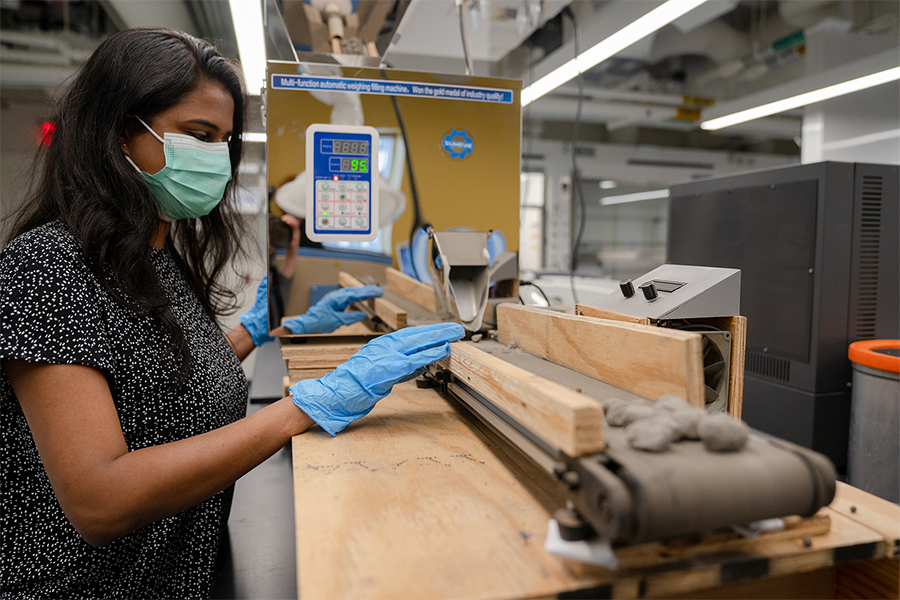Converting unused coal ash waste stream into a sustainable source for concrete aggregate
Nathan Snizaski
Jun 21, 2022
Relative to the glass waste, the waste CCA industry is a massive, toxic waste stream–the largest waste material collected in Pennsylvania and second largest in the U.S. behind household trash. Drexel University and SusMaX LLC partnered to develop an innovative manufacturing technology to produce a lightweight aggregate (LWA) produced from waste coal combustion ash (CCA) and waste glass for concrete construction applications. Together, waste CCA and waste glass can be used synergistically to produce value-added LWA that can be used in construction. This manufacturing technology has a two-fold effect of promoting landfill diversion while preventing natural resource exploitation.
“Glass is inherently recyclable, but it often comes with some impurities during the recycling process,”says Amir Yaghoob Farnam, associate professor of civil, architectural, and environmental engineering at Drexel University. “Some recycling industries are not as interested in glass waste as much as other solid waste because glass must go through a lot of washing or a specific cleaning process to make reusable products. We’re using those materials in our process–the glass that may be more likely to be discarded because of the complexity of removing impurities.”

Source: Jeff Martin, Drexel University
Manufacturing PA participant Sharyina Visvalingam (Ph.D. student)
SusMaX LLC is currently focused on coal ash-based aggregate and partnered with Drexel University to explore the potential of waste CCA/waste glass aggregate to expand its product portfolio. Farnam shares that the support of the Manufacturing PA Innovation Program has yielded promising outcomes. “We are getting very interesting results that demonstrate the synergistic effect of waste glass and unused coal ash working together to manufacture a lightweight aggregate that has broad potential for geotechnical and concrete applications.”
Farnam categorizes the major use cases for SusMaX’s innovative LWA into three major applications: geotechnical, concrete, and agricultural. In geotechnical applications, SusMaX’s LWA can be used for bridge embankments and filling applications. In concrete applications, Farnam suggests that the SusMaX LAW can be used in both precast concrete as well as ready-mix types to lower the total weight of concrete slabs, for example. In agricultural applications, LWA can be used to support crop growth through slow-release watering.
“Lightweight aggregates are porous and have a high-absorption capacity,” says Farnam. “They can intake water that can be released over time, like an extended release for watering a plant, which is helpful in agricultural applications.”
Farnam says that Pennsylvania has more coal ash waste deposited in landfills than any other state in the US. “We have many, many mountains of coal ash waste in the US, and certainly in Pennsylvania. We can excavate them and start producing aggregates from the waste that’s just sitting in landfills as a sustainable source for creating construction products, for agriculture, and beyond.”
Farnam indicates that finding a way to keep more coal combustion ash and waste glass from ending up in landfills is important for future generations.
“These waste streams can cause a lot of environmental problems but also health problems for people.” Namely, heavy metal leaching can contaminate the surrounding soil beyond the designated area for landfills. “From the first time that I joined Drexel and was introduced to this idea, I’ve been excited to explore a way to recycle solid waste.”
Sustainability serves as a major driver in Farnam’s excitement to advance this manufacturing technology to help protect natural resources. To produce traditional lightweight aggregates, raw materials like clay are mined, broken into smaller materials, and used in kilns to make gravel-like pieces for concrete applications, which is more destructive to nature than reusing solid waste as a source material. SusMaX uses unused coal ash in their technology that is applicable in concrete applications.
“If we can scale the waste coal combustion ash for the use in aggregate manufacturing, we probably have enough raw materials in landfills that will last us and produce lightweight aggregate for many decades. We have enough waste coal ash waste in the US that we could supply raw materials for this technology even for the next generation. Imagine that–instead of using natural materials, we can use a solid waste stream that has been there waiting to be used for a long time.”Imagine that–instead of using natural materials, we can use a solid waste stream that has been there waiting to be used for a long time.
Amir Yaghoob Farnam, Associate Professor, Drexel University